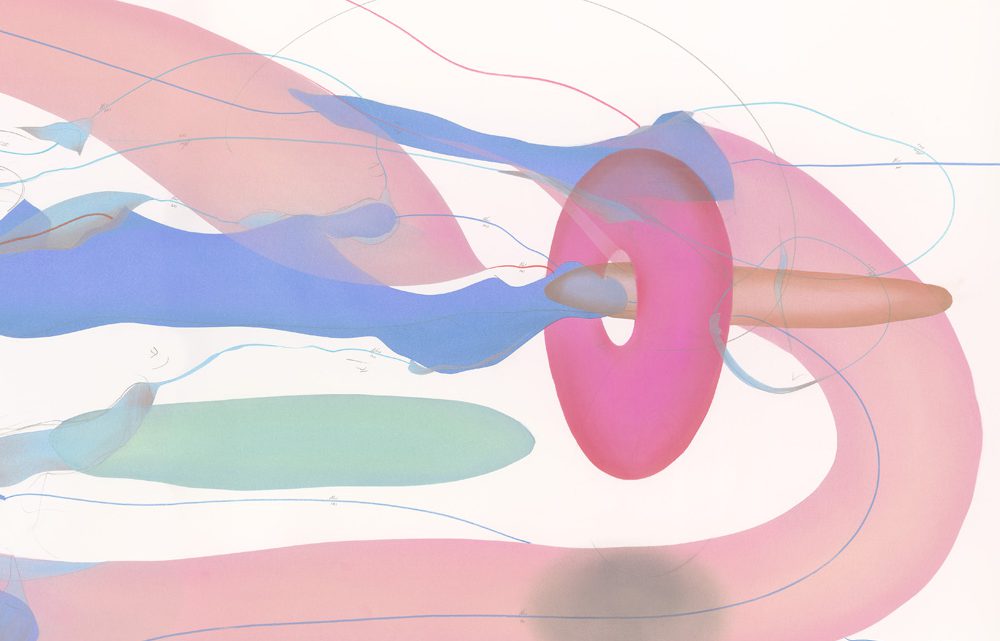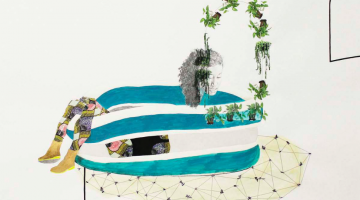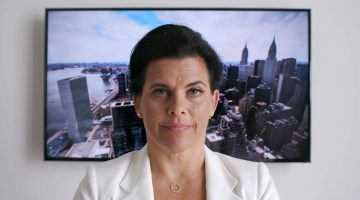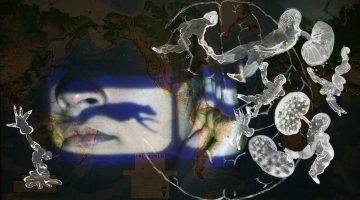Jorinde Voigt: Considerations in the Now
David Nolan
527 W 29th St, NY
May 4 – June 11, 2016
How might lines behave respectfully? How might they convey spontaneity and movement without sacrificing precision? Jorinde Voigt’s mixed media works on paper at David Nolan create a new logic for forms: microscopic and galactic, organic and plastic, each revolving around its own temporal axes.
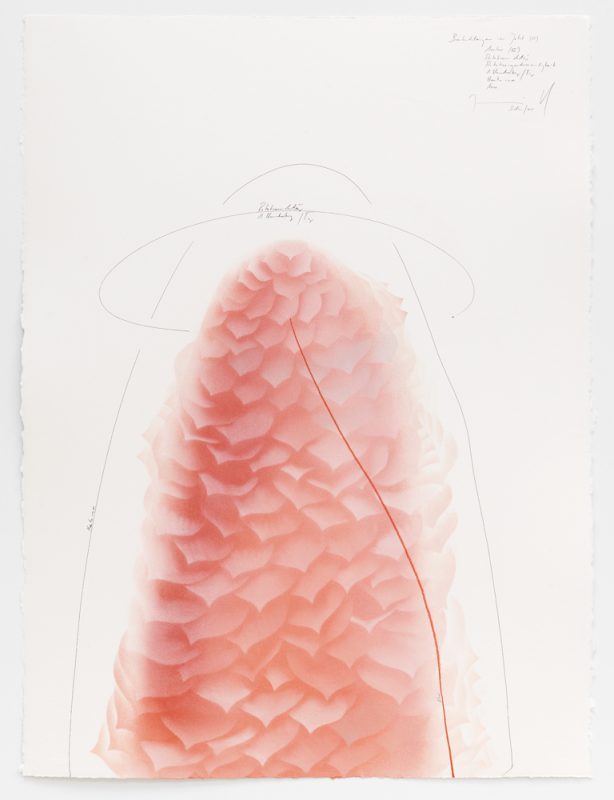
Jorinde Voigt, Beobachtungen im Jetzt (35) Avatar XI, 2015. Pastel, oil pastel, ink, pencil on paper, 29 15/16 x 22 1/16 in; 76 x 56 cm © Jorinde Voigt, Courtesy David Nolan Gallery, New York
In the main gallery, on the west wall, two small drawings in pastel, ink, and pencil (both roughly 29” x 22”) provide a logical point of departure into the larger works (up to 72” x 99”). These drawings, Beobachtungen im Jetzt (35) Avatar XI and Beobachtungen im Jetzt (36) Avatar XII (both 2015) give the show its name; Beobachtungen im Jetzt might be translated as “Considerations in the Now.” Parabolic mounds resembling hedges or mounds of feathers rise up from the bottom edge of the page. Protruding leaves composing the mound fade at their tips from pink to white in Avatar XI and from green to red in Avatar XII. Tracing the perimeter of each mound, a thin pencil line is annotated “Heute,” the German word for today. A red line is traced from the maximum of the green parabola to the top edge of the page in Avatar XII and from the maximum of the pink parabola to its base in Avatar XI. Voigt has labeled this red line “Now.” A third line in each composition seems to revolve around the crown of the parabola, tracing its form—as though conical—to find the circumference. When this third line crosses “Heute,” the perimeter line, it politely segments itself, revealing its creation to be consequent, after today.
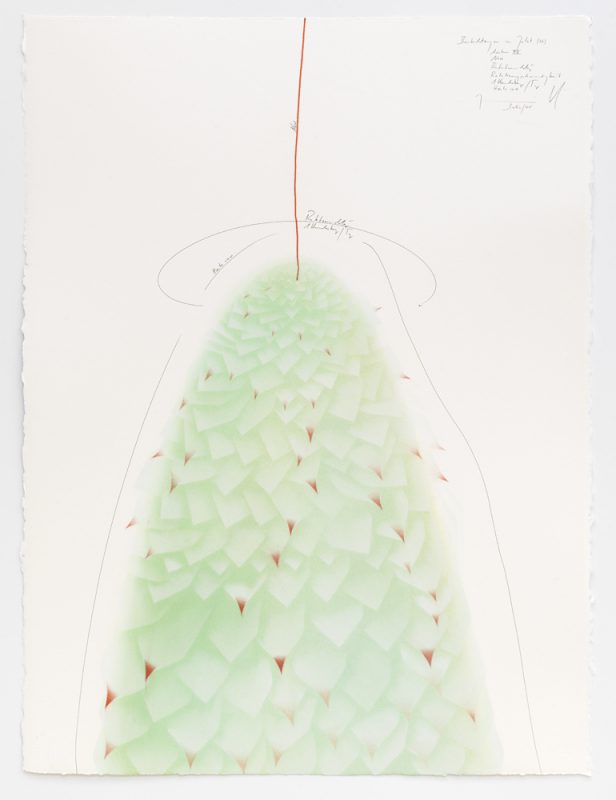
Jorinde Voigt, Beobachtungen im Jetzt (36) Avatar XII, 2015. Pastel, oil pastel, ink, pencil on paper, 29 15/16 x 22 1/16 in; 76 x 56 cm © Jorinde Voigt, Courtesy David Nolan Gallery, New York
As twins, these works can be examined for their differences to ascertain the allowable deviations from an aesthetic logic prevalent in all works. “Now” is always colored red, and the other drawn pencil lines seem to provide alternate conceptions of time that, in their intersections, convey the temporality after which they are named. After “Heute,” Voigt draws a small arrow pointing to an infinity sign, suggesting that the perimeter line it labels represents an eternal configuration of time.
Are these drawings representations of alternate modes of perception? Voigt notes in her statement on the work that she was interested in C. G. Jung’s writings, which led her to conceive of these drawings as “thought diagrams.” Indeed, Voigt’s drawings are formally similar to theosophist Annie Besant’s early twentieth-century Thought Forms, suggesting an interior psychological methodology. The multiple overlapping temporalities then index the simultaneity of memories, or of consciousness itself. While in these first two drawings the lines and forms are relatively clear, in the following works many lines are obscured, making it increasingly difficult to follow the trajectories of time.
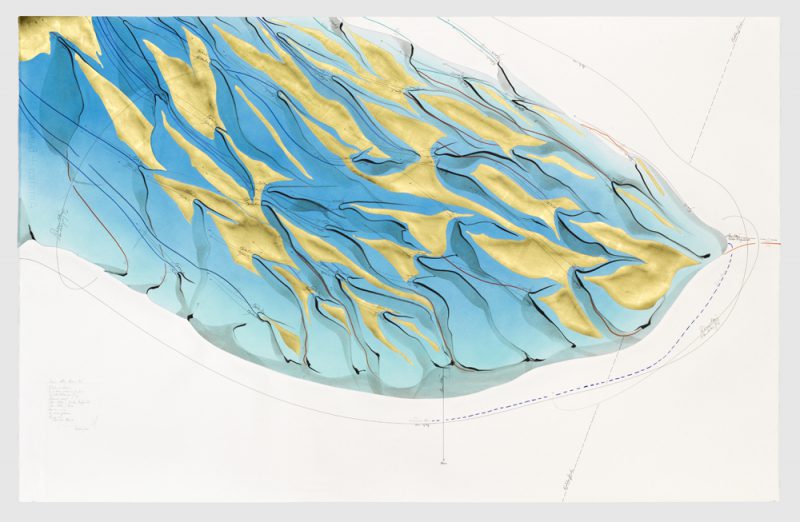
Jorinde Voigt, Hauro-Algorithmus (6), 2015. Ink, indian ink, gold leaf, pastel, oil pastel, pastel on paper, mounted on canvas, 35 7/16 x 55 1/2 in: 90 x 141 cm © Jorinde Voigt, Courtesy David Nolan Gallery, New York
Hauro-Algorithmus (6) (2015) reveals a bit more of Voigt’s process. Gold leaf scales swim inside a light blue undulating form that is similarly scored by colored, annotated lines. Here, though, there many red and blue lines marked as “Now”—40, in fact. A note at the lower left corner seems to itemize the “contents” of the drawing as a list of the different temporalities within it, and it is here that Voigt has written, “Now (1) – (40).” New temporalities, or new perceptions of it, are drawn over in layered lines: “Gestern” (yesterday), “Vorgestern” (day before yesterday), “Morgen” (tomorrow), “Übermorgen” (day after tomorrow). This work also contains a new dotted line in blue: “Possible Now.” In its complexity, Hauro-Algorithmus (6) is a tangled knot of rules, a choreographed dance of lines, forms, and consequences. From this association, it is not unreasonable to jump to Trisha Brown’s 1975 notational drawings that function as dance diagrams, or even her performance piece It’s a Draw/Live Feed, in which the artist “began to treat the frame of the paper as a stage,” as Peter Eleey has written. Using her limbs to hold pencils that would track the movements of her body exploring the page, Brown created “a mystery novel in two dimensions.”

Jorinde Voigt, März, 2016. Ink, oil pastels, pastel, pencil on paper, 44 7/8 x 141 3/4 in; 114 x 360 cm © Jorinde Voigt, Courtesy David Nolan Gallery, New York
The sequel to Brown’s mystery is März (2016), one of Voigt’s most recent works in the show. Hung on the far wall of the gallery, it is the most varied and compelling drawing thus far. A nebulous, predominantly pink oval donut hangs suspended in the center of the rectangular composition. Darker pink around its perimeter, the form reads as three dimensional, like the earlier parabolic forms. Yet here, the pink form is like the motherly universe within which new forms play. Smaller magenta donut forms hover in its reach. Through them, phallic bullets zoom, leaving behind jagged blue trails. As described in the press release, Voigt indeed used her body in a sort of dance to create this work: “Sitting atop a vast sheet of paper, the artist documents the areas in which her body comes into contact.” The system results in a density reminiscent of Julie Mehretu’s drawings and a comic levity not unlike Kenny Scharf’s vibrant cartoon characters. Voigt again leaves annotations in März, but they are here more ambiguous and fragmented. Voigt again itemizes the lines (read temporalities) used in the drawing: “Now (1-14), Now (15-37), Now (38-45)” are in dark blue, cyan, and red, respectively. The pigmentations are also revealed. The area labeled “1.)” is marked “Ultramarine Deeo 390 + 388/ Indigo 136/Phthalo Blue.” Yet because some numbered colors do not appear to have a corresponding key, it seems that parts of the page have been hidden or cut off; Voigt then implies notes beyond the drawing, or the rest of the scroll of drawing paper, furthering the imagination of infinity that her earlier works’ notations first invoked.
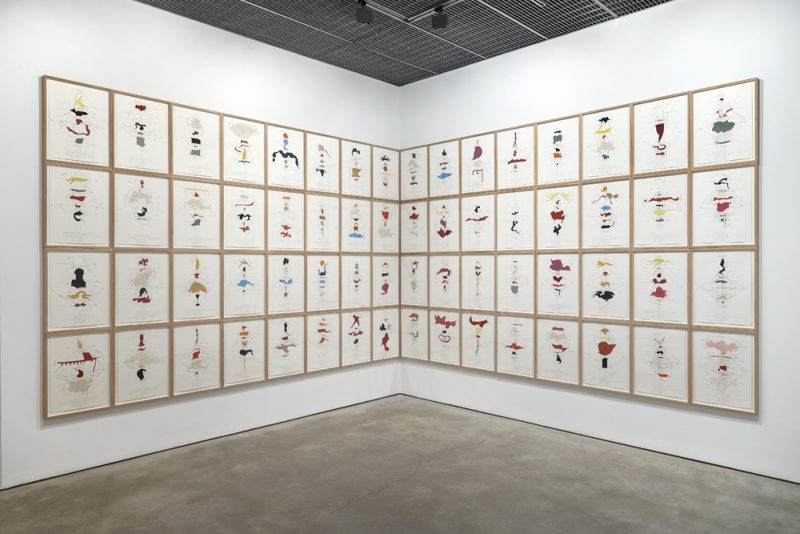
Installation view: “Jorinde Voigt: Considerations in the Now”, David Nolan Gallery, New York, (May 4 – June 11, 2016). Photo: Thomas Müller
In the back room, Voigt’s system seems to explode. These are in fact the earliest works in the show, dating from 2012. In a tight grid, 64 drawings are each composed around a stack of cut-out colored paper forms pasted onto the white paper. Heavily marked, this series, Japanese Erotic Art 17th-19th Century (1-64), appropriates the eponymous work into new extracted forms that could be simultaneously microscopic, industrial, architectural, and bodily. Each drawing is subtitled with the names of what must be the original pictures corresponding to each of Voigt’s cut forms. A sampling includes “Scenes from the Pleasure District,” “Erotic Painting,” “The Gods of Intercourse,” “Mirror of the Vagina,” and “Sexy Robes of the Bedchamber.” Some of Voigt’s forms are ambiguous, but most are numbered and outlined or elaborated upon in pencil. When the artist does include fuller forms, they become a foot, instrument, skeleton, man’s legs and penis, or mass of entangled lovers’ limbs. It is easy to jump back from this grid into the larger works like März, having seen how Voigt breaks down and recombines forms to create intricate works with their own stacks, axes, and orbits.
Upstairs on the mezzanine are more explorations of this system—clearly she’s been having fun—through maps, Mobius strips painted in bronze and gold, and drips and splashes of ink. The splashes in the 2014 works feel less essential; they deviate from the meticulous rhythmic quality of Voigt’s other works, which feel exploratory in ways that to not betray the satisfaction of order. But in other works from 2015/2016, like the two Space-Study works, Voigt seems to have found new elements with which to play, like a seismographic line, steadily pulsating but still parallel to the neighboring lines. The page becomes the frame for an ecosystem, an organism engaging in intercourse of the most literal and visual kind, where pellets of bronze paint shoot from the orange heart of one blue cocoon to the heart of the cocoon’s other half. Finally, the bud of it all: two studies from 2014, devoid of color, demonstrate only a method of splitting arrows to form a sort of Pascal’s triangle in which, beginning at the center of the page a multiplying out to its edge, the lines overlap and thicken.
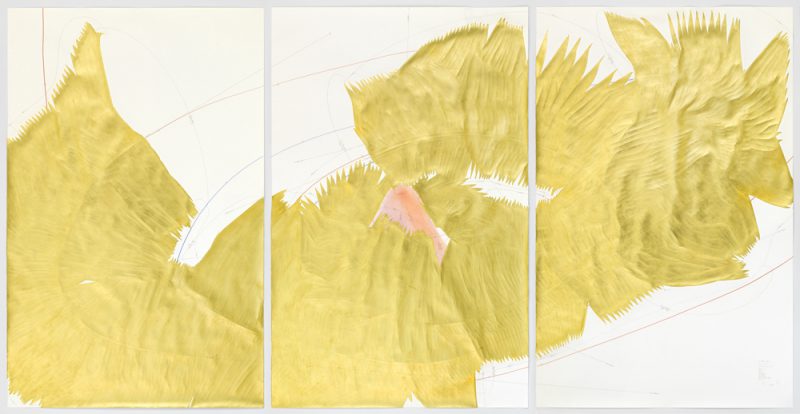
Jorinde Voigt, 5 Cavallini – Sequences, 2015. Ink, gold, oil pastel, pastel, pencil; triptych, each sheet: 86 5/8 x 55 1/8 in (220 x 140 cm), overall framed dimensions: 90 3/4 x 178 in © Jorinde Voigt, Courtesy David Nolan Gallery, New York
Voigt’s affinity for algorithms seems to have been the crux of the entire show; but these are not so much representations of mathematical phenomena as explorations of a cognitive order, culminating (at least with this curation) in the largest two works—Infinite Now (2015), a horizontal mass composed of overlapping black feathers forming checkered serpentine tentacles, and 5 Cavallini – Sequences (2015), a triptych shimmering with an agglomeration of cut gold shapes that meld into wings. The wings radiate from the core of central panel, a pink pastel orb. Matte and mesmerizing, it is imbued with the substance of a psyche or soul.
